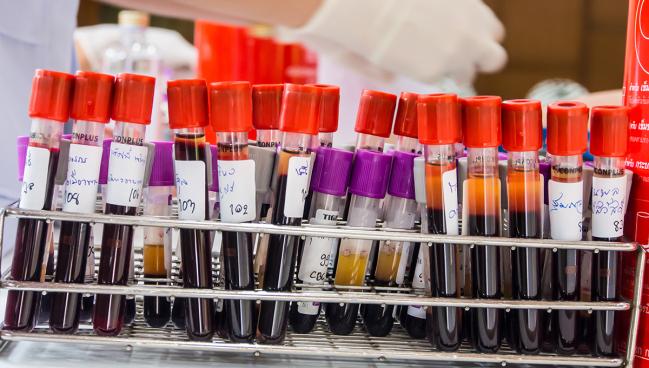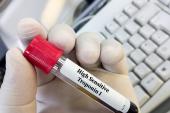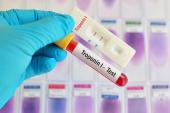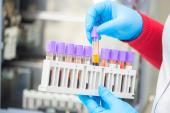High Troponin Signals Increased Mortality Risk in Broad Hospital Cohort
(UPDATED) The study offers a snapshot of troponin levels in an unselected group of patients. What to do about them is unclear.

In an unselected group of patients who underwent a blood test at a hospital for any reason, an elevated cardiac troponin I concentration was associated with a higher mortality risk through more than 2 years of follow-up, according to newly released results from the CHARIOT study.
The relationship was seen for both cardiovascular mortality and noncardiovascular death, researchers led by Jonathan Hinton, MD (University of Southampton, England), report in a study published online this week in Heart.
Of note, the vast majority of the cohort (91.4%) did not have a clinical indication for troponin testing, which differs from much of the prior research looking into the relationship between troponin and outcomes, senior author Nick Curzen, BM(Hons), PhD (University of Southampton), told TCTMD.
“I think what’s really novel is in a hospital population, inpatient or outpatient, if you just took this snapshot test once in someone at random, it does genuinely appear to give you an idea of the chances of living or dying in a way that not really any other tests do,” Curzen said. Additional research is needed to figure out how this information can be applied in practice, but, he added, “this could be clinically valuable.”
Commenting for TCTMD, Andrew Chapman, MD (University of Edinburgh, Scotland), congratulated the investigators on performing a well-conducted study, which he called “quite unique.”
“To my knowledge, this is the largest unselected population study which has looked at patients where troponin was not necessarily measured on clinical indication,” he said. “As a result, the clinical context in which it is being interpreted is quite different to usual practice.”
That said, the findings “are probably comparable with what we already know—that cardiac troponin irrespective of the cause is associated with prognosis and with mortality,” he added, noting that “increasingly, we’re recognizing that this relationship is complicated and affected by cardiac comorbidity, but also by age, renal function, and other noncardiac comorbidity.”
Fred Apple, PhD (Hennepin Healthcare/Hennepin County Medical Center and the University of Minnesota, Minneapolis), also commenting for TCTMD, said the results did not surprise him, noting that many studies over the years have shown that troponin is related to adverse outcomes across an array of cohorts. “This is well known in the literature,” he said.
Still, it’s not clear what to do with a one-time test showing an elevated troponin level. “You’d have to take the clinical picture into consideration. Troponin is just one part of the puzzle,” Apple said.
“People know it’s a marker of risk,” he continued. “The question is what do we do with it, if anything’s done with it, if it’s just a random sampling with nothing else going on?”
Moving Beyond Acute MI Diagnosis
Currently, troponin testing is a key part of diagnosing acute MI, but more and more studies have been pointing to the value of the biomarker, particularly when measured using high-sensitivity assays, for assessing prognosis in a variety of clinical settings beyond ACS. One recent study, for example, showed that high-sensitivity troponin testing identified patients with stable coronary disease who had a greater risk of MI or cardiovascular death in the coming years.
CHARIOT is a prospective, observational study of 20,000 consecutive and unselected adults (median age 61 years; 53%) undergoing a blood test for any indication at University Hospital Southampton NHS Foundation Trust, as inpatients or outpatients or within the emergency department. Previous results showed that about 5% of the cohort had a cardiac troponin I concentration above the upper limit of normal and that having an elevated level was associated with a greater risk of 1-year mortality.
The current analysis extends follow-up out to a median of 2.2 years, and explores both CV and other causes of death. Over that time span, 14.1% of patients died from any cause, with a significantly higher rate among those who had a troponin I concentration above the manufacturer-recommended upper limit of normal (44.8% vs 12.4%; P < 0.001). The most common cause of death was malignancy (46.3%), followed by CVD (12.8%).
Detecting a troponin and knowing what it means and what you can do about it are very different things. Nick Curzen
Multivariable analysis showed that the log10-transformed troponin concentration was independently associated with all-cause mortality (HR 1.76; 95% CI 1.65-1.88), with consistent results among inpatient, outpatients, and those seen in the emergency department. An increased troponin was linked to greater risks of both cardiovascular mortality (HR 2.53; 95% CI 2.20-2.90) and noncardiovascular death (HR 1.99; 95% CI 1.86-2.12).
Having the troponin test requested by the clinical team, which occurred in the minority of cases (8.6%), was associated with a lower risk of all-cause death during follow-up (HR 0.62; 95% CI 0.53-0.72). “This somewhat paradoxical observation could be explained by the fact that cardiac troponin assays are primarily requested to exclude type 1 MI in patients presenting with chest pain, the vast majority of whom are clinically well at presentation,” the investigators write. “Patients in whom cardiac troponin was not requested may represent a group of patients who are more unwell and hence more likely to have elevated cardiac troponin concentrations.”
In a landmark analysis that excluded deaths within the first 30 days, troponin was still related to mortality risk during follow-up. Curzen said these patients will continue to be followed to see if the association persists over a longer time period.
Not Ready for Clinical Application
Before considering a clinical use for these findings, additional research is needed, including validation studies in other health systems and clinical settings and investigations of potential interventions to modify the risk revealed by a one-time elevated troponin, the investigators say.
It would also be interesting to see if similar relationships would be observed in healthier populations, as the cohort included in the current study was undergoing testing for some reason, Curzen said. In addition, he indicated, a closer look at individuals with a high troponin level but no manifest cardiac disease could be informative when it comes to evaluating potential interventions to lessen mortality risk.
Speculating about potential uses for this information in the future, Curzen said troponin testing might eventually be useful as a screening tool and as a biomarker of general unwellness reflective of disease processes that are affecting the heart, even if indirectly.
But there is not yet evidence to support such an approach, Curzen stressed, saying that troponin should not be measured in every patient coming to the hospital.
“In fact, I spend my whole time encouraging people who work in intensive care and acute medicine not to do a troponin unless they think the patient’s had a type 1 MI, because detecting a troponin and knowing what it means and what you can do about it are very different things,” he said.
Regarding the latest CHARIOT findings, Curzen said: “At the moment we don’t know what to do with this result except that it should trigger a lot more investigation into what the troponin means in the future. So it’s not ready to be applied to clinical practice.”
There is always a risk when we are implementing tests and we don’t know what to do with the results. Andrew Chapman
Chapman agreed, saying “there is always a risk when we are implementing tests and we don’t know what to do with the results, and I think certainly at present it’s advocated that cardiac troponin is only measured when there is a clinical indication. The reason for that is that if troponin elevation is incorrectly interpreted this could adversely affect the patient’s treatment.” In a patient with gastrointestinal hemorrhage, for example, cardiovascular stress may cause the troponin to rise, but treatments for acute coronary syndrome could exacerbate bleeding, he said.
Moreover, there remains a question about whether the relationship between elevated troponin and mortality can be modified in a way to reduce future events, Chapman said.
For now, he emphasized, the study “really does highlight the importance of appropriate selection of patients for cardiac troponin testing, and any clinicians reading this study I think need to be very mindful of the prevalence of raised cardiac troponin in patients who are hospitalized and in the outpatient setting who’ve got important comorbidity and only request that test if you have a specific question—for example, do you think this patient has an acute coronary syndrome or have they had ischemic chest pain which you’re trying to investigate further.”
Chapman added, “Cardiac troponin is elevated in a wide variety of circumstances not limited to primary coronary or cardiac disease, and I think it’s essential that all clinicians who are working in a hospital environment consider the etiology of cardiac troponin elevation, a broad differential diagnosis, and the appropriateness of further investigation.”
Todd Neale is the Associate News Editor for TCTMD and a Senior Medical Journalist. He got his start in journalism at …
Read Full BioSources
Hinton J, Mariathas MN, Gabara L, et al. Association between troponin level and medium-term mortality in 20,000 hospital patients. Heart. 2023;Epub ahead of print.
Disclosures
- The study was funded by an unrestricted research grant from Beckman Coulter for the high-sensitivity troponin assays.
- Curzen reports unrestricted research grants from Boston Scientific, HeartFlow, and Beckman Coulter; speaker/consultancy fees from Abbott Vascular, HeartfFow, and Boston Scientific; and travel sponsorship from Edwards Lifesciences, Biosensors, Abbott, Lilly/D-S, St. Jude Medical, and Medtronic.
- Hinton reports no relevant conflicts of interest.





Comments